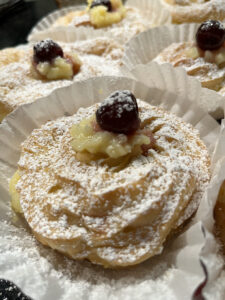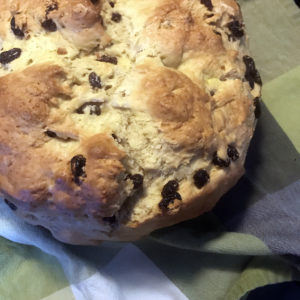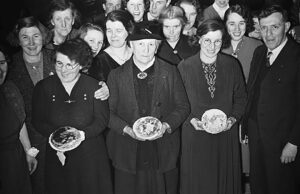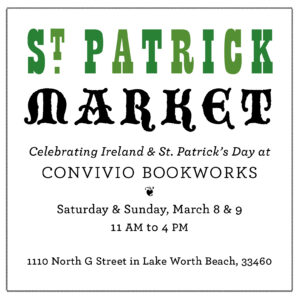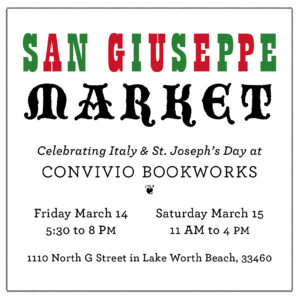It’s the 19th of March: St. Joseph’s Day. And what St. Patrick’s Day is to the Irish, so St. Joseph’s Day is to the Italians. In Sicily, folks will be eating Pasta con le Sarde: very often Bucatini, and always with chopped sardines and anchovies, with chopped fennel, raisins, and saffron: flavors which nod to the Arabic influence upon Sicily and the rest of Southern Italy (from where my family hails). This pasta dish, which is topped with toasted breadcrumbs (to symbolize St. Joseph’s carpentry sawdust) is particularly Sicilian.
My Grandma Cutrone, who was from Palo del Colle, in Apulia, near Bari, would build an altar to St. Joseph in her home each March, and to all the visitors who came to see it, she would give oranges and boxes of animal crackers. This was before my time, so I never got to see the altar, save for in poorly-lit silent 8 mm home movies, nor did I ever get to ask why the animal crackers, though I can guess why the oranges: oranges, for centuries before they were commonplace, were beautiful, valuable gifts that symbolized the golden sun and its promised return after a long winter. Oranges made lovely gifts at Christmastime, and, I imagine, were just as welcome at the start of Spring.
St. Joseph’s Day is also Father’s Day in Italy, which is fitting, as Joseph was Mary’s husband and foster father to her son, Jesus. One of my favorite songs for the day is an old carol for Christmas called “The Cherry Tree Carol.” In it, Joseph is so very human and he comes across as a real jerk until he comes to understand, thanks to the cherry tree’s bowing down, the greater mystery he has become part of. It’s a song that’s been sung for many centuries, but I have two favorite recordings of it. One is by Emmylou Harris and is just so beautifully done. The other is from a Christmas Revels performance called Ribbon of Highway. It’s sung by Charmaine Li-Lei Slaven and I just love her emphasis on Joseph’s standing around while Mary gathers cherries… Joseph’s grumpiness and humanity really shines through in Charmaine’s version.
We call St. Joseph “San Giuseppe,” and while my family does not make Pasta con le Sarde (we are not Sicilian, after all) for St. Joseph’s Day, we will enjoy Zeppole di San Giuseppe. We make zeppole at New Year’s Eve, too, but Zeppole di San Giuseppe are different: these are delicious pastries that are filled with custard and Amarena cherries. They are Lenten treats that are meant to be eaten just on and around the 19th of March, though some Italian bakeries now bake them all year long (which, as you might imagine, I do not approve of). Seth has come to call the day San Giuzeppole Day (and that I do approve of). If you do nothing else today to celebrate, find yourself an Italian bakery and buy some Zeppole di San Giuseppe (or Sfingi di San Giuseppe, which are filled with sweet ricotta cream (like cannoli), rather than custard) and be sure to serve your pastries with strong espresso. Perfetto!
This year, as is often the case, San Giuseppe welcomes us to Spring, for the next day, March 20 at 5:01 AM Eastern Daylight Time, will bring the Vernal Equinox to the Northern Hemisphere and a brief period of roughly balanced sunlight and darkness across the globe. It is the start of Spring by the almanac for us, while in the Southern Hemisphere, it is the start of Autumn. The Wheel of the Year never ceases its slow turning, and now, once we pass this equinox moment, our Northern Hemisphere days begin to log more daylight hours than night. We are halfway between the Midwinter Solstice we left in December and the Midsummer Solstice we approach in June. But San Giuseppe, he begs us to put the Moka pot on the stove, brew an espresso with a nice crema, perhaps, and sit at the table and visit with friends and family and some zeppole. There is plenty of time for work, and plenty of time for Lenten austerity. Today, we get to enjoy ourselves.
*
Those are my sister Marietta’s homemade Zeppole di San Giuseppe in the photo above. So good!
A reminder that our shop will be closed for the rest of March, but we will reopen again on the First Saturday of April, and indeed all the Saturdays of April, for our Springtide Saturdays series. Your online orders are still welcome, and we will be filling orders this week, but orders placed on March 20 or later won’t be filled until the first week of April.
We also have two in-house workshops coming up this spring! Collagraph Printmaking with instructor Kim Spivey is on Sunday April 6, and I’ll be teaching a workshop called Pure Bookbinding (these are books made without adhesive) on Sunday May 4.
